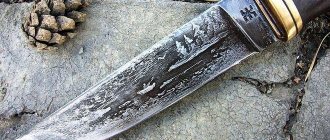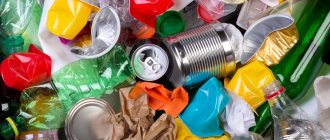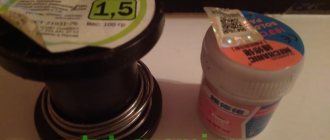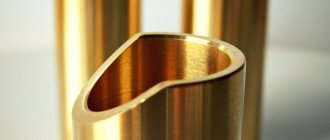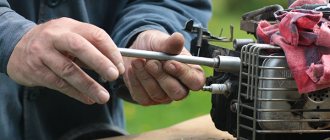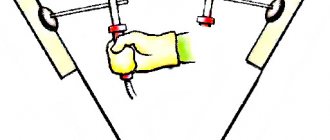Best selling pickling paste INOX D/GEL SUPER PLUS Paste for pickling the welding seam of stainless steel after welding
In stock Etching paste INOX D/P SUPER PLUS Intensive paste for etching stainless steel welding seam
Best seller Pickling gel ENERGY PICKLER GEL PLUS Gel paste for intensive pickling of stainless steel, odorless
In stock Pickling gel ENERGY PICKLER GEL Pickling gel for stainless steel, odorless
In stock Safe etching gel FUTUR DEK DBA Gel for etching stainless steel without nitric and hydrofluoric acids
In stock Etching paste INOX P 400 Etching paste for AISI 430 INOX P 400
In stock Etching gel INOX D/GEL SUPER PLUS SPRAY Means for etching large surfaces of stainless steel by spraying
Best seller Etching paste INOX D/GEL STRONG Fast-acting etching paste. Removes stubborn oxides in 3-5 minutes
In stock INOX D/GEL LIGHT SPRAY Gel spray for etching stainless steel without matting effect
In stock Pickling bath INOX D/L Liquid pickling agent for stainless steel by immersion
In stock Stainless steel passivator PASSINOX Stainless steel passivator for instant formation of a passive layer…
Best selling Passivator FUTUR PASS ADF GEL Stainless steel passivator. In stock.
In stock Passivator PASS OX Liquid passivator of stainless steel AISI 630, 304, 316, 321
In stock Pickling solution INOX D/L 400 Pickling liquid for stainless steel AISI 430
In stock Pickling agent ENERGY PICKLER GEL PLUS... Non-toxic means for pickling stainless steel by spraying. Without…
- 1
The high corrosion resistance of stainless steel is achieved through the formation of a chemically resistant passive layer of chromium oxide. To use stainless steel outdoors, in highly corrosive environments or for contact with chemicals, such a layer must evenly and completely cover the entire metal surface.
During the manufacture of stainless steel elements, the metal surface is subject to various deformations and damage due to thermal and mechanical treatment at all stages. Oxide layers on welds, dirt particles and other traces such as free iron can penetrate deep into the surface of the material during manufacturing processes. A protective layer cannot form in these areas, making stainless steel highly susceptible to rapid corrosion.
However, the process of etching and passivation of stainless steel removes and dissolves oxides located on the surface of stainless steel, including those formed during the welding process or during secondary heating, as well as corrosive particles and slag formations. After etching, a chemically clean metal surface is achieved, on which an optimal protective passive layer can be formed. For complete stainless steel pickling technology, FORSTEX offers a wide range of products for metal processing under different operating conditions.
Reasons why processing is important
During the manufacture of numerous structures using stainless steel as the main material, welding methods are actively used due to the functioning of an electric arc in an inert gas environment.
Despite the formation of relatively smooth and strong seams, they are characterized by the presence of an unattractive appearance, resulting in the need to treat stainless steel welds. Thus, the place of the welded joint is characterized by the presence of a mirror color, while the area near the seam is yellow and its many shades.
In the case of the formation of a pattern in the form of scales, the presence of small black stripes is noted in the resulting grooves. After a certain period of time, there may be a risk of rust forming in these areas.
Phenomena of this nature are a consequence of exposure to excessively high temperature conditions, which results in overheating in the welding area. When high temperatures are present, alloying elements burn out with simultaneous depletion, which results in a change in color and an increase in the degree of vulnerability to external factors.
At the end of the process, a film is formed, which is characterized by a low level of resistance to aggressive environmental influences, which leads to the gradual development of corrosion at the treatment site.
Pickling paste
The Salyut Association is a well-known supplier of certified products and materials for construction and industrial production. Having large, specially equipped warehouse facilities, we have accumulated large inventories of products to uninterruptedly satisfy customer requests. Constantly studying market conditions and demand, we are expanding the range of products and additional services.
Taking advantage of our offers, the customer can count on a personal approach and qualified assistance in the selection of materials, loyal prices and high quality materials.
Mechanical grinding
Stainless steel is characterized by the presence of a high level of corrosive properties, which determine its active use in environments where liquids are often used. Although products made from such material are in active contact with water and are subject to preliminary welding, their appearance does not change significantly over time. This feature can be traced as a result of the use of certain processing principles.
Among the main processing options, it is customary to highlight mechanical grinding of stainless steel after welding. During this process, the top layer of the oxide component that forms at the welding site and represents a weak point in the entire structure is eliminated. Distinct color transitions and existing irregularities in the weld joint are also eliminated.
This process is characterized by the following sequence:
- eliminating waves in the area of the metal seam by using a thick grinding wheel and grinder, as well as leveling out any bulges present;
- using petal circles for the functioning of the grinder; the main goal of such elements is to carry out work more accurately, along with longer process times and consumption of materials, which is especially important for large-scale work;
- the use of a specially designed equipment complex in the form of a grinding machine, the result of which is a one-color matte coating;
- mandatory use of a respirator to reduce the risk of abrasive dust and metal particles entering the respiratory tract that are in the air during work.
Alkaline etching methods
The following methods are distinguished:
- Aging in soda. The sodium nitrate content should range from 20-40%, heated to a temperature of 460-500 degrees Celsius. Etching in such an environment lasts for 15 minutes. Some austenitic grades of stainless steel are prohibited from being heated above 450 degrees. This can lead to intergranular corrosion. This is followed by a rinsing step in a large amount of water, followed by a 5-minute immersion in a sulfuric acid bath and up to 10 minutes in a nitrate bath.
- Known in England since the first half of the 19th century, the etching method is combined with passing an electric current through the part being etched. At a current density of 11 A/m2, 15 seconds is sufficient. This reaction rate is associated with the electrolysis process. The release of sodium and hydrogen at the cathode contributes to the reduction of oxides. The reduced metal is deposited on the surface. This type of etching allows you to obtain degreased metal, characterized by purity and uniformity. This method uses soda. Variations are possible with the composition and addition of calcium chloride. This method is used for etching flat, rod blanks, and drawn products.
- Treatment with sodium hydrides is based on reduction by exposing the metal to sodium and hydrogen. The presence of sodium hydride is achieved by the interaction of hydrogen and sodium, which is in a molten state. A cylinder without a bottom plane is placed in molten caustic soda. The top plane has a hole. Sodium is poured into this hole, it reacts on the surface of the bath. A stream of hydrogen is passed through a spot of sodium on caustic soda. A hydride is formed and diffuses throughout the bath. Achieving the required concentration of 1-2% sodium hydride occurs within controlled threshold values. In the absence of an air separation product, dissociated ammonia is used. The parts are heated in such a bath to 400 degrees Celsius. Stainless steels show good pickling results with this technique and duration of 4-17 minutes. After etching, it is recommended to thoroughly rinse the parts. If necessary, carry out additional treatment in a nitrate bath. Given the high cost of this method, its obvious advantage is the fact that the metal does not interact with the etchant. Metal losses are minimal. Lower process temperatures reduce coolant costs and reduce operational safety.
There are certain rules that must be followed for any of the presented methods. Among them, priority is the treatment of the metal surface before etching, removal of the oxide film, and degreasing. The etching process is no less important.
Polishing stainless steel after welding
The next step in the complex of processing carried out in relation to the area of welding work is polishing the stainless steel after welding. It should be noted that not only individual areas of the product are subjected to such a process, but also the entire surface of the product as a whole, which guarantees a shiny final look.
Polishing provides an even greater level of cleaning of the surface being treated by obtaining a solid and smooth area, which subsequently results in the ability to withstand the external influence of aggressive liquids.
Initially, the area of the welds is exposed to a disk of vulcanite, the purpose of which is to give the weld the required shape and depth by forming the structure of the concave sample.
The next step is considered to be the application of a special paste intended for polishing. In most cases, GOI paste is used. The main objective of the polishing process is to achieve a mirror-like surface with the immediate absence of previously present matte spots.
Alkaline etching
Treating the surface of stainless steel with molten caustic soda is called alkaline etching. It should be noted that during this process the oxide film is destroyed, while the chemicals do not react with the metal. An increase in temperature promotes corrosion of the oxide film, improving the quality of the treated surface. Rapid cooling in liquid also helps to improve the treated surface.
It is almost impossible to achieve 100% results with this type of processing. Residual films from chromium oxides, nickel and iron oxides are possible on the metal. Among the recommendations for final finishing of such defects is a short-term treatment in a nitrate bath.
Gels and acids for processing
In order to eliminate the presence of color transitions resulting from the welding process, as well as to neutralize the formation of an oxide layer that promotes the corrosion process, etching of stainless steel welds is widely used. This method falls into the category of acid exposure for the purpose of processing the material.
The best option is to use hydrochloric and sulfuric acid to treat stainless steel welds. If it is not possible to use the above compounds, nitric or hydrofluoric acid can be used. These substances are intended to be produced in the form of a gel and paste for etching welds on stainless steel.
It is also currently considered possible to purchase specially designed aerosols for such purposes.
Bath materials
Choosing the right material for making etching baths is a difficult task for chemists and materials scientists.
- ceramic coated
- glass covered brick
- wood, lead-coated concrete
- rubber derivatives
- Certain grades of stainless steel for acid baths.
The content of nitrogenous acid with impurities of hydrofluoric or hydrochloric acid allows the use of the same materials. The only exceptions are lead as a coating, ceramics with a high silicon content, due to their interaction. It is quite possible to use steel in alkali baths, monitoring the progress and intensity of electrolysis in close proximity to the material. Under certain conditions and acid content, its temperature, and nature, it is possible to use stainless steel grades for pickling tanks. Such, for example, as 8Х18Н8М or 10Х20Н25М4.
From the information provided in this review, we can conclude that the processing mode, the chemical composition of the bath, the need for additional mechanical processing, and the use of electrolysis should be determined based on specific initial conditions (steel grade, state of the oxide film, technological capabilities) and regulated in the context of the expected final result .
Welding stainless steel pipes
To weld stainless pipes, the following connection methods should be used:
1. Arc welding using tungsten electrodes in a gas environment is used for pipes whose walls have a thickness of 1.5 mm or more. and higher.
2. Plasma welding can be used to join pipes with different wall thicknesses.
3. Semi-automatic submerged arc welding is intended for products with thick walls (over 10 mm).
4. Pulse mode of semi-automatic welding, performed in a shielding gas environment, is suitable for stainless steel up to 2 mm thick. The work is carried out with a short arc using a consumable electrode.
5. The jet transfer method of semi-automatic welding is designed to work with thick metal.
6. However, the most common and popular method is manual welding of stainless steel pipes. The work is carried out using direct current of reverse polarity using electrodes with basic and rutile coatings. Read more about this here.
